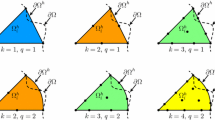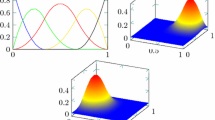Abstract
This paper extends the use of one-dimensional elements with node-dependent kinematics to the analysis of Stokes flows. According to the Carrera Unified Formulation, the primary variables of the flow, velocity and pressure, are expressed as arbitrary expansions of the generalized unknowns. The novel implementation proposed in this work allows to increase the accuracy of the model only in the areas of the domain where it is required; i.e. close to boundaries, barriers or sudden expansion. Refined one-dimensional models based on Taylor and Lagrange expansions are used in this work and some typical applications are proposed to assess this novel technique, including Stokes flows in cylindrical and non-conventional domains. For each numerical example, different combinations of one-dimensional models have been considered to account for different kinematic approximations of flows, and the results, compared with analytical or finite volume solutions, highlight the capabilities of the proposed approach to handle non-conventional boundary conditions with ease and in preserving the computational cost without any accuracy loss.
Similar content being viewed by others
References
V. C. Rideout and D. E. Dick. Difference-differential equations for fluid flow in distensible tubes. IEEE Transactions on Biomedical Engineering, 14(3): 171–177, 1967.
N. Westerhof, F. Bosman, C.J. De Vries, and A. Noordergraaf. Analog studies of the human systemic arterial tree. Journal of Biomechanics, 2(2): 121–143, 1969.
J. Ottesen. A fluid dynamical model of the aorta with bifurcations. Tekst 297, Rotskilde Univ., 1995.
G. Karniadakis and S. Sherwin. Spectral/Hp Element Methods for CFD (Numerical Mathematics and Scientific Computation). Oxford University Press, New York, 1999.
J.P. Pontaza and J.N. Reddy. Spectral/hp least-squares finite element formulation for the Navier-Stokes equations. Journal of Computational Physics, 190(2): 523–549, 2003.
N.P. Smith, A.J. Pullan, and P.J. Hunter. An anatomically based model of transient coronary blood flow in the heart. SIAM Journal of Applied Mathematics, 62(3): 990–1018, 2002.
S. Guzzetti, S. Perotto, and A. Veneziani. Hierarchical model reduction for incompressible fluids in pipes. International Journal for Numerical Methods in Engineering, 114(5): 469–500, 2017.
L. Formaggia, F. Nobile, A. Quarteroni, and A. Veneziani. Multiscale modelling of the circulatory system: a preliminary analysis. Computing and visualization in science, 2(2–3): 75–83, 1999.
L. Formaggia, J.F. Gerbeau, F. Nobile, and A. Quarteroni. On the coupling of 3D and 1D Navier — Stokes equations for flow problems in compliant vessels. Computational Methods in Applied Mechanics and Engineering, 191(6–7): 561–582, 2001.
E. Carrera and E. Zappino. One-dimensional finite element formulation with node-dependent kinematics. Computers & Structures, 192: 114–125, 2017.
E. Carrera, E Zappino, and G Li. Finite element models with node-dependent kinematics for the analysis of composite beam structures. Composites Part B: Engineering, 132: 35–48, 2018.
E. Carrera, M. Filippi, and E. Zappino. Node-dependent kinematic one-dimensional models for the analysis of rotating structures. In ASME 2017 International Mechanical Engineering Congress and Exposition, Tampa, Florida, US, November 2017. American Society of Mechanical Engineers.
G. Zappino, E. and Li and E. Carrera. Node-dependent kinematic elements for the dynamic analysis of beams with piezo-patches. Journal of Intelligent Material Systems and Structures, 29(16): 3333–3345, 2018.
E. Carrera, M. Cinefra, M. Petrolo, and E. Zappino. Finite element analysis of structures through Unified Formulation. Wiley, 2014.
E. Carrera and G. Giunta. Refined beam theories based on a unified formulation. International Journal of Applied Mechanics, 2(1): 117–143, 2010.
E. Carrera and M. Petrolo. Refined beam elements with only displacement variables and plate/shell capabilities. Meccanica, 47(3): 537–556, 2012.
G. Giunta, F. Biscani, S. Belouettar, A.J.M. Ferreira, and E. Carrera. Free vibration analysis of composite beams via refined theories. Composites Part B: Engineering, 44(1): 540–552, 2013.
E. Carrera, M. Petrolo, and A. Varello. Advanced beam formulations for free-vibration analysis of conventional and joined wings. Journal of Aerospace Engineering, 25(2): 282–293, 2012.
A. Varello, A. Pagani, D. Guarnera, and E. Carrera. Analysis of Stokes flows by Carrera Unified Formulation. Advances in Aircraft and Spacecraft Science, 5(3): 363–383, 2018.
O.C. Zienkiewicz, R.L. Taylor, and R.L. Taylor. The finite element method, volume 3. McGrawhill London, 1977.
A. Quarteroni. Numerical Models for Differential Problems, volume 1. Springer, 2009.
F. Brezzi. On the existence, uniqueness and approximation of saddle-point problems arising from Lagrange multipliers. Revue Francaise de Automatique, Informatique, Recherche Operationnelle. Analyse Numerique, 8: 129–151, 1974.
A. Varello. Advanced higher-order one-dimensional models for fluid-structure interaction analysis. Ph.D Thesis — Politecnico di Torino, 2013.
E. Zappino, G. Li, A. Pagani, and E. Carrera. Global-local analysis of laminated plates by node-dependent kinematic finite elements with variable esl/lw capabilities. Composite Structures, 172: 1–14, 2017.
E. Carrera, E. Zappino, and G. Li. Finite element models with node-dependent kinematics for the analysis of composite beam structures. Composites Part B: Engineering, 132: 35–48, 2018.
S. Stera and R. Skalak. The history of Poiseuille’s Law. 1993.
OpenFOAM Fundation. OpenFOAM. https://doi.org/www.openfoam.com, 2011–2014.
Author information
Authors and Affiliations
Additional information
Conflict of interest
On behalf of all authors, the corresponding author states that there is no conflict of interest.
Rights and permissions
About this article
Cite this article
Guarnera, D., Zappino, E., Pagani, A. et al. Finite elements with node dependent kinematics and scalable accuracy for the analysis of Stokes flows. Aerotec. Missili Spaz. 97, 208–218 (2018). https://doi.org/10.1007/BF03406055
Published:
Issue Date:
DOI: https://doi.org/10.1007/BF03406055




